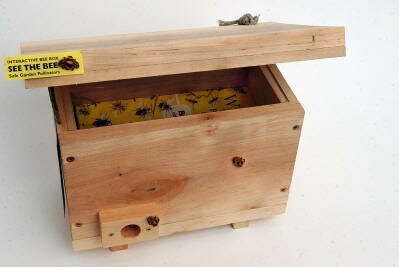|
Join our nest box trial...
|
These days most good wildlife gardens contain several bird nesting boxes. The birds use them, and we love watching them building their nests and raising chicks. Not surprisingly, bumblebees need homes too! They probably struggle to find natural nesting sites, so we're keen to encourage people to start providing artificial sites in their gardens....
|
|
Several types of bumblebee nest box are available commercially, but it seems that they're very rarely used! We're running a large trial of several different designs, some you can buy, and some you can easily make for a few pence. We hope to find out what works, and what doesn't - the more people that take part the better. Please help us by trying some of these designs, and your results (both positive and negative!)
|
|
Most bumblebees look for a dry, dark, ventilated cavity with a small entrance hole that they can access at ground level. Many species prefer an entrance tunnel - 18mm in diameter or more and 30-50cm long. Any old bit of hose or pipe will do, although garden hose may be too narrow. A pin or nail across the centre of the entrance will stop large snails from blocking the tunnel, and small drainage holes will prevent water pooling. We've done a bit of research and come up with some suggestions. However, feel free to try whatever you like - be creative - and let us know how you get on! All sorts of designs are possible, using old bricks, stones, or pieces of timber.
Nests should be sited in a sheltered spot along a 'linear feature' (a hedge, bank or fence), out of direct sunlight. Put in a handful of dry moss, upholsterer’s cotton, hair felt or hamster bedding from a pet shop for the bees to mould into a nest. Cotton-wool and fibre-glass insulation should probably be avoided, as the bees may get tangled up in the fine fibres.
|
|
Design 1
This is the typical 'bumblebee nesting box' and is available from a number of suppliers. Ecotopia sell a well made and very good value model which we suggest you try (£15.99, pictured) - they are kindly donating 10% of sales to BBCT
We suspect that these are more likely to work if sunk into a bank so that the hole is at ground level. Better still, attach a 30-50cm length of pipe or tube to the entrance hole (see above). Bury the pipe, and make the entrance an obvious hole in the ground so that the queen can find it easily.
Ideally, put a cradle made of chicken-wire in the nest (for ventilation), and fill this with a large handful of nesting material (see above).
|

|
|
Design 2
You can make this one yourself - all you need is a flowerpot and a bit of tube or pipe more than 18mm in diameter.
Sink an upturned >20cm diameter flower pot into the ground. Put a slate/ tile over the drainage holes to keep out rain. Run a hose or pipe underground to the pot, leaving a prominent entrance. Be sure to make drainage holes in the pipe.
Again, make a chicken-wire cradle for ventilation, and fill with a generous handful of nesting material.
|
 |
|
Design 3
Some bumblebee species nest above ground, and they occasionally use bird nesting boxes. Unlike birds, they never collect nesting material, so you'll have to put some in the box for them.
Any bird box would probably do, but you could try these excellent value “roosting pockets” sold by Ecotopia (£3 each, pictured) and add a 'hat' to keep the rain out. An alternative roofed design is also available - 10% of sales go to BBCT
Hang them somewhere shady and sheltered, perhaps in a hedge, 0.5 - 2m above the ground. Try to reduce the size of the entrance hole, otherwise birds will probably move in!
|
 
|
|
Design 4
The final design is another one you can easily make. You could even modify your existing patio, and create hundreds of sites!
Simply dig a cavity in the ground (roughly 15cm deep and 25 cm wide) and cover with a paving slab or piece of thick plywood. Dig a few small channels at the sides to provide entrance holes and ventilation (~2cm wide). Try to make the entrance holes as obvious as possible so that the queen finds them.
Again, put a handful of nesting material in the cavity, ideally in a chicken-wire cradle.
|
 |
|